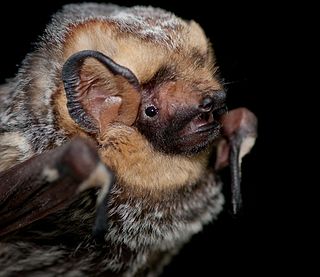
Plestiodon egregius, the mole skink, is a species of small lizard endemic to the Southeastern United States.

Lasiurus is the genus comprising hairy-tailed bats. The generic name Lasiurus is derived from the Greek lasios (hairy) and oura (tail). It contains some of the most attractive bats (Chiroptera) in the whole continent of North America, including such species as the eastern red bat, L. borealis, and the hoary bat, L. cinereus. They are very robust and long-winged, with fast and strong flight; several species fly during parts of the day, especially when migrating south in autumn. The hoary bat and red bat will often fly in daylight during winter.

Calamus is a genus of the palm family Arecaceae. These are among several genera known as rattan palms. There are an estimated 400 species in this genus, all native to tropical and subtropical Asia, Africa, and Australia. They are mostly leaf-climbing lianas with slender, reedy stems. To aid scrambling some species have evolved hooks on the underside of the midrib, or more commonly by modified "pinnae" or tendrils in the form of stout, backward-pointing spines. These stems may grow to lengths of 200 metres.

The Lahontan redside is a cyprinid fish of the Great Basin in eastern California and western Nevada.

Astraptes is the genus of flasher butterflies. They belong to the skipper butterfly subfamily Eudaminae, which was long included with the spread-winged skippers (Pyrginae) as a tribe. They are found in the Nearctic and Neotropical ecozones.

The Lake Wales Ridge National Wildlife Refuge is part of the United States National Wildlife Refuge (NWR) System, located in four separated areas on the Lake Wales Ridge east of US 27 between Davenport and Sebring Florida. The 1,194 acre (4.8 km2) refuge was established in 1990, to protect a host of plants and animals. It is also the first to be designated primarily for the preservation of endangered plants, and is not open to the general public. It contains a high proportion of remaining Florida scrub habitat. It is administered as part of the Merritt Island National Wildlife Refuge.

The big red bat, is a species of vesper bat from South and Central America.

Billom is a commune in the Puy-de-Dôme department in the Auvergne-Rhône-Alpes region in central France.
Calamus egregius is a species of flowering plant in the Arecaceae family. It is found only in the Hainan region of China. Its natural habitats are subtropical or tropical moist lowland forests and subtropical or tropical moist montane forests.

Dvinosaurus is a genus of extinct temnospondyl amphibian from the Late Permian of Russia. The first three species, D. primus, D. secundus, and D. tertius, were described by Russian paleontologist Vladimir Prokhorovich Amalitskii in 1921. Dvinosaurus was first found near the village of Sokolki in Arkhangelsk and named after the Northern Dvina River, which was close to the locality where it was discovered. The holotype is cataloged as PIN2005/35, and consists of only a skull. Amalitskii's D. tertius is now considered synonymous with D. secundus. Two additional species, D. egregius, and D. purlensis, were named by Mikhail Shishkin in 1968. These were named from a fossilized skull and a partial lower jaw, respectively.
Pogonocherini is a tribe of longhorn beetles of the Lamiinae subfamily.
Cosmotomidius is a genus of longhorn beetles of the subfamily Lamiinae, containing the following species:
Cosmotomidius cacaoensis is a species of beetle in the family Cerambycidae. It was described by Touroult et al. in 2010. It is known from French Guiana.
Cosmotomidius crudiaphilus is a species of beetle in the family Cerambycidae. It was described by Touroult et al. in 2010. It is known from French Guiana.
Cosmotomidius elongatus is a species of beetle in the family Cerambycidae. It was described by Touroult et al. in 2010. It is known from French Guiana.
Cosmotomidius setosus is a species of beetle in the family Cerambycidae. It was described by Audinet-Serville in 1835. It is known from Paraguay, Argentina and Brazil. It measures between 5.3 to 7.4 mm.
Cosmotomidius vincus is a species of beetle in the family Cerambycidae. It was described by Machado and Monné in 2009. It is known from Bolivia. It measures between 7.9 to 8.5 mm.
Mesonauta egregius is a species of cichlid fish native to the Meta and Vichada River basins in South America. It is typically found near aquatic plants in shallow water and reaches a length up to 8.2 cm (3.2 in).
Margarinotus egregius is a species of clown beetle in the family Histeridae. It is found in North America.
Myrmex egregius is a species of antlike weevil in the family of beetles known as Curculionidae. It is found in North America.










